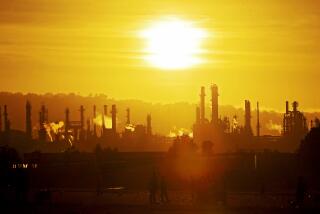Capitalist Cleanup : Auction of Pollution Rights Called a Success
- Share via
The nation’s first auction in rights to emit air pollution brought more bidders to the table than expected.
The U.S. Environmental Protection Agency and the Chicago Board of Trade announced Tuesday that 171 bids--from electric utilities, brokerage firms, environmental groups and private investors--competed for more than 150,000 allowances that were sold by sealed bid, bringing in $21 million. Each allowance permits utilities to emit one ton of sulfur dioxide over one year.
The innovative federal program is designed to control acid rain at half the cost of conventional pollution-control methods by allowing electric utilities to trade allowances among themselves and through brokers or other outside investors. Sulfur dioxide, a byproduct of burning coal, causes acid rain.
“It is the historic first step” in the most ambitious attempt in the world to use market incentives to reduce pollution, said Patrick H. Arbor, chairman of the Chicago Board, in announcing the results. The auction drew more than twice as many bids as available allowances.
Arbor also said Tuesday that the Chicago Board of Trade would hold “complementary” auctions of its own, beginning in June, as well as a previously announced futures market in the allowances.
The new market has been growing “slowly like a snowball but gaining speed, and it’s encouraging,” said Michael Gildea, a regulatory analyst at Edison Electric Institute, the trade group for the nation’s large investor-owned utilities.
Tuesday’s auction was the first indication of a market price for the allowances. Prices per allowance ranged from $122 to $450, averaging somewhat lower than many observers had expected.
The annual auction is part of a trading program required under the 1990 Clean Air Act in an attempt to cut the costs of pollution control. The law aims to cut U.S. sulfur dioxide pollution emissions by the year 2000 to half what the levels in 1980 were.
But the program allows utilities to decide how they want to meet the standards, which will be phased in at two levels, becoming stricter in 1995 and again in 2000. Utilities not yet meeting the standards may choose to change fuels or install scrubbers to lower emissions--or to buy excess allowances from another utility to put off such an investment. Utilities that lower their emissions can sell their excess permits on the open market.
Prices for allowances to meet the 1995 standards averaged $156. Those to meet the year 2000 ceiling averaged $136.
Though acid rain primarily affects East Coast states, California utilities closely observed the proceedings but didn’t participate. They will likely be sellers in the trade because of the state’s early efforts to cut emissions, in large part by increasing reliance on natural gas to produce electricity. Midwest utilities, particularly, rely on coal, which produces high amounts of sulfur dioxide during combustion.
The auction results reflected “very good prices,” though only a first glimpse of the market, according to Nader Mansour, manager of environmental regulation at Southern California Edison. “There was a lot of speculation that the prices might be depressed because . . . if you’re paying today for a commodity that you won’t be able to use until the year 2000, some discounting might take place.”
Mansour says that Edison expects to have about 20,000 extra allowances to sell as the market develops.
Pacific Gas & Electric Co., based in San Francisco, also expects to have about 20,000 allowances to sell. San Diego Gas & Electric Co. estimates that it will have 13,000.
Though utilities, and some brokerage firms, ended up with the vast majority of the allowances sold, successful bidders also included such environmental groups as the Natural Resources Defense Council, Resources for the Future and the National Healthy Air License Exchange. Each bought one share at a high price.
National Healthy Air’s president, David Webster, says his group will retire their single permit from use, as a symbolic gesture to cut pollution faster than the program intends. But buying larger numbers of shares is a strategy being contemplated by other environmentalists.
“Our only intent on this go-round,” Webster said, “was to obtain one permit to demonstrate that it can be done. . . . This is really history in the making.”
Such a strategy by environmentalists is perfectly welcome by those who conceived the acid rain market, which includes University of Chicago Prof. Ronald H. Coase, whose promotion of market-based incentives to solve environmental problems won him a Nobel Prize in 1991.
But Coase expects broader results from the new market.
Not only does a market achieve “pollution reduction at the lowest price,” Coase said Tuesday, “but I feel that over the long run it will enable us to discover . . . just what the costs are” that society is investing to rid the nation of its legacy of pollution.
More to Read
Sign up for Essential California
The most important California stories and recommendations in your inbox every morning.
You may occasionally receive promotional content from the Los Angeles Times.










